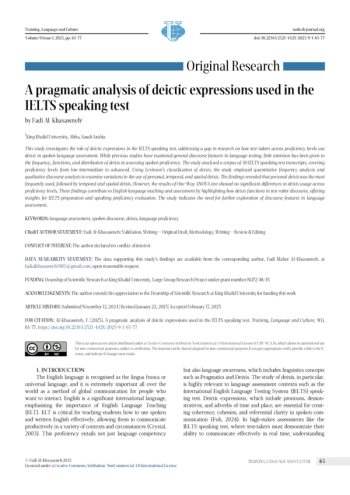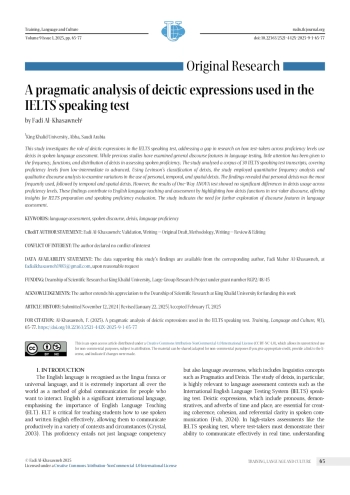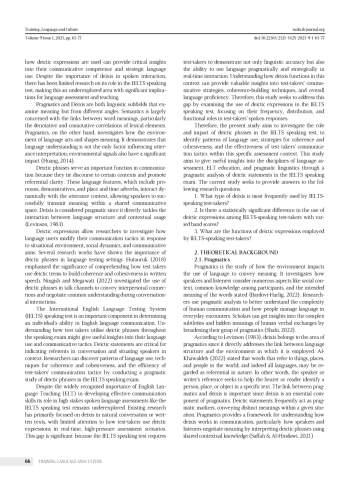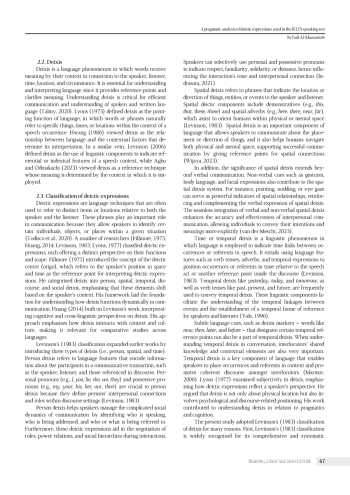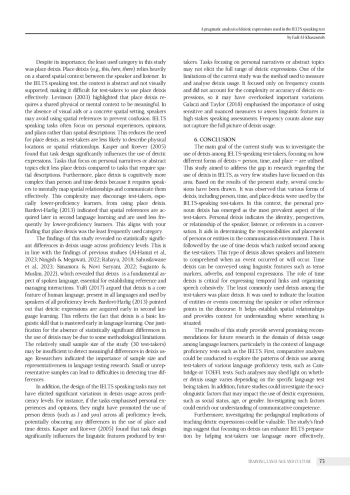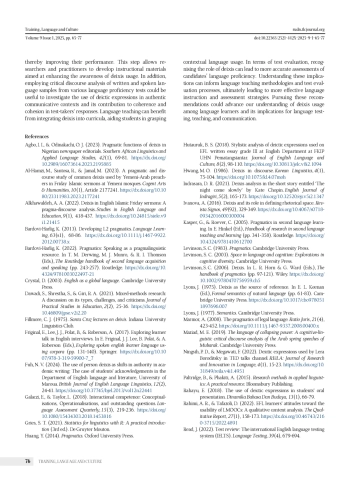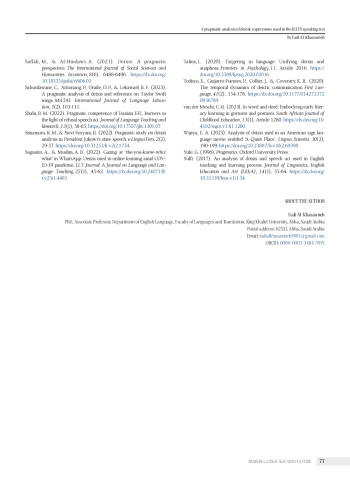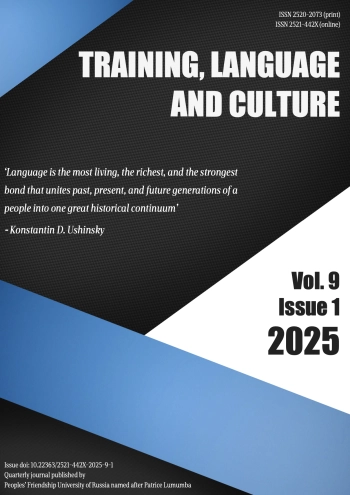This study investigates the role of deictic expressions in the IELTS speaking test, addressing a gap in research on how test-takers across proficiency levels use deixis in spoken language assessment. While previous studies have examined general discourse features in language testing, little attention has been given to the frequency, functions, and distribution of deixis in assessing spoken proficiency. The study analysed a corpus of 30 IELTS speaking test transcripts, covering proficiency levels from low-intermediate to advanced. Using Levinson’s classification of deixis, the study employed quantitative frequency analysis and qualitative discourse analysis to examine variations in the use of personal, temporal, and spatial deixis. The findings revealed that personal deixis was the most frequently used, followed by temporal and spatial deixis. However, the results of One-Way ANOVA test showed no significant differences in deixis usage across proficiency levels. These findings contribute to English language teaching and assessment by highlighting how deixis functions in test-taker discourse, offering insights for IELTS preparation and speaking proficiency evaluation. The study indicates the need for further exploration of discourse features in language assessment.
Идентификаторы и классификаторы
The English language is recognised as the lingua franca or universal language, and it is extremely important all over the world as a method of global communication for people who want to interact. English is a significant international language, emphasising the importance of English Language Teaching (ELT). ELT is critical for teaching students how to use spoken and written English effectively, allowing them to communicate productively in a variety of contexts and circumstances (Crystal, 2003). This proficiency entails not just language competency but also language awareness, which includes linguistics concepts such as Pragmatics and Deixis.
Список литературы
1. Agbo, I. I., & Odinakachi, O. J. (2023). Pragmatic functions of deixis in Nigerian newspaper editorials. Southern African Linguistics and Applied Language Studies, 42(1), 69-81. DOI: 10.2989/16073614.2023.2195885 EDN: EVTABJ
2. Al-Hamzi, M., Santosa, R., & Jamal, M. (2023). A pragmatic and discourse study of common deixis used by Yemeni-Arab preachers in Friday Islamic sermons at Yemeni mosques. Cogent Arts & Humanities, 10(1), Article 2177241. DOI: 10.1080/23311983.2023.2177241
3. Alkhawaldeh, A. A. (2022). Deixis in English Islamic Friday sermons: A pragma-discourse analysis. Studies in English Language and Education, 9(1), 418-437. DOI: 10.24815/siele.v9i1.21415 EDN: CVVXMY
4. Bardovi-Harlig, K. (2013). Developing L2 pragmatics. Language Learning, 63(s1), 68-86. DOI: 10.1111/j.1467-9922.2012.00738.x
5. Bardovi-Harlig, K. (2022). Pragmatics: Speaking as a pragmalinguistic resource. In T. M. Derwing, M. J. Munro, & R. I. Thomson (Eds.), The Routledge handbook of second language acquisition and speaking (pp. 243-257). Routledge. DOI: 10.4324/9781003022497-21
6. Crystal, D. (2003). English as a global language. Cambridge University Press.
7. Dawadi, S., Shrestha, S., & Giri, R. A. (2021). Mixed-methods research: A discussion on its types, challenges, and criticisms. Journal of Practical Studies in Education, 2(2), 25-36. DOI: 10.46809/jpse.v2i2.20 EDN: VPVRZX
8. Fillmore, C. J. (1975). Santa Cruz lectures on deixis. Indiana University Linguistics Club.
9. Friginal, E., Lee, J. J., Polat, B., & Roberson, A. (2017). Exploring learner talk in English interviews. In E. Friginal, J. J. Lee, B. Polat, & A. Roberson (Eds.), Exploring spoken english learner language using corpora (pp. 131-140). Springer. DOI: 10.1007/978-3-319-59900-7_7
10. Fuh, N. V. (2024). The use of person deixis as shifts in authority in academic writing: The case of students’ acknowledgements in the Department of English language and literature, University of Maroua. British Journal of English Language Linguistics, 12(2), 24-41. DOI: 10.37745/bjel.2013/vol12n22441 EDN: FAPJVC
11. Galaczi, E., & Taylor, L. (2018). Interactional competence: Conceptualisations, Operationalisations, and outstanding questions. Language Assessment Quarterly, 15(3), 219-236. DOI: 10.1080/15434303.2018.1453816
12. Gries, S. T. (2021). Statistics for linguistics with R: A practical introduction (3rd ed.). De Gruyter Mouton.
13. Huang, Y. (2014). Pragmatics. Oxford University Press.
14. Hutauruk, B. S. (2018). Stylistic analysis of deictic expressions used on EFL written essay grade III at English Department at FKIP UHN Pematangsiantar. Journal of English Language and Culture, 8(2), 98-110. DOI: 10.30813/jelc.v8i2.1094
15. Hwang, M. O. (1986). Deixis in discourse. Korean Linguistics, 4(1), 75-104. DOI: 10.1075/kl.4.07moh
16. Indrasara, D. R. (2021). Deixis analysis in the short story entitled ‘The night come slowly’ by Kate Chopin. English Journal of Indragiri, 5(2), 165-173. DOI: 10.32520/eji.v5i2.1347 EDN: GDUDGA
17. Ivanova, A. (2016). Deixis and its role in defining rhetorical space. Revista Signos, 49(92), 329-349. DOI: 10.4067/s0718-09342016000300004
18. Kasper, G., & Roever, C. (2005). Pragmatics in second language learning. In E. Hinkel (Ed.), Handbook of research in second language teaching and learning (pp. 341-358). Routledge. DOI: 10.4324/9781410612700
19. Levinson, S. C. (1983). Pragmatics. Cambridge University Press.
20. Levinson, S. C. (2003). Space in language and cognition: Explorations in cognitive diversity. Cambridge University Press.
21. Levinson, S. C. (2006). Deixis. In L. R. Horn & G. Ward (Eds.), The handbook of pragmatics (pp. 97-121). Wiley. DOI: 10.1002/9780470756959.ch5
22. Lyons, J. (1975). Deixis as the source of reference. In E. L. Keenan (Ed.), Formal semantics of natural language (pp. 61-83). Cambridge University Press. DOI: 10.1017/cbo9780511897696.007
23. Lyons, J. (1977). Semantics. Cambridge University Press.
24. Marmor, A. (2008). The pragmatics of legal language. Ratio Juris, 21(4), 423-452. DOI: 10.1111/j.1467-9337.2008.00400.x
25. Maziad, M. E. (2019). The language of collapsing power: A cognitive-linguistic critical discourse analysis of the Arab spring speeches of Mubarak. Cambridge University Press.
26. Ningsih, P. D., & Megawati, F. (2022). Deictic expressions used by Lera Boroditsky in TED talks channel. REiLA: Journal of Research and Innovation in Language, 4(1), 15-23. DOI: 10.31849/reila.v4i1.4951 EDN: DQEWJR
27. Paltridge, B., & Phakiti, A. (2015). Research methods in applied linguistics: A practical resource. Bloomsbury Publishing.
28. Rahayu, E. (2018). The use of deictic expressions in students’ oral presentation. Dinamika Bahasa Dan Budaya, 13(1), 66-79.
29. Rahimi, A. R., & Tafazoli, D. (2022). EFL learners’ attitudes toward the usability of LMOOCs: A qualitative content analysis. The Qualitative Report, 27(1), 158-173. DOI: 10.46743/2160-3715/2022.4891
30. Read, J. (2022). Test review: The international English language testing system (IELTS). Language Testing, 39(4), 679-694. EDN: LBINWS
31. Saffah, M., & Al-Hindawi, A. (2021). Deixis: A pragmatic perspective. The International Journal of Social Sciences and Humanities Invention, 8(6), 6488-6496. DOI: 10.18535/ijsshi/v8i06.03 EDN: ICPELH
32. Sahusilawane, C., Aritonang, P., Oraile, O. P., & Lekawael, R. F. (2023). A pragmatic analysis of deixis and reference on Taylor Swift songs. MATAI: International Journal of Language Education, 3(2), 103-111.
33. Shahi, B. M. (2022). Pragmatic competence of Iranian EFL learners in the light of refusal speech act. Journal of Language Teaching and Research, 13(1), 58-65. DOI: 10.17507/jltr.1301.07 EDN: HVWBXG
34. Simamora, R. M., & Novi Suryani, R. (2022). Pragmatic study on deixis analysis in President Jokowi’s state speech. e-LinguaTera, 2(2), 29-37. DOI: 10.31253/lt.v2i2.1734
35. Sugianto, A., & Muslim, A. B. (2022). Gazing at ‘the-you-know-who/what’ in WhatsApp: Deixis used in online learning amid COVID-19 pandemic. LLT Journal: A Journal on Language and Language Teaching, 25(1), 45-62. DOI: 10.24071/llt.v25i1.4485 EDN: WCFFAV
36. Talmy, L. (2020). Targeting in language: Unifying deixis and anaphora. Frontiers in Psychology, 11, Article 2016. DOI: 10.3389/fpsyg.2020.02016
37. Todisco, E., Guijarro-Fuentes, P., Collier, J., & Coventry, K. R. (2020). The temporal dynamics of deictic communication. First Language, 41(2), 154-178. DOI: 10.1177/0142723720936789 EDN: ZNUPVH
38. van der Mescht, C. R. (2023). In word and deed: Embodying early literacy learning in gestures and postures. South African Journal of Childhood Education, 13(1), Article 1280. DOI: 10.4102/sajce.v13i1.1280
39. Wijaya, E. A. (2023). Analysis of deixis used in an American sign language movie entitled ‘A Quiet Place’. Lingua Scientia, 30(2), 190-199. DOI: 10.23887/ls.v30i2.69398
40. Yule, G. (1996). Pragmatics. Oxford University Press.
41. Yulfi. (2017). An analysis of deixis and speech act used in English teaching and learning process. Journal of Linguistics, English Education and Art (LEEA), 14(1), 55-64.
Выпуск
Другие статьи выпуска
In a thirty-year career as a teacher of English as a foreign and second language, Nik Peachey set up his own online system for producing weekly lesson plans for teachers, focusing on social issues and addressing areas of language use of special value to language teachers wanting to introduce new topics and activities to their classes at different levels of proficiency. Like many of his colleagues, he has moved beyond the use of the computer and the Internet to produce and circulate lesson plans and now has published an online book on the role of artificial intelligence and its applications, such as ChatGPT, in language learning and teaching. Entitled The Manual of AI-Mediated Autonomous Teacher Development, the book is available online. Nik Peachey takes teachers of English through the theory and practice of artificial intelligence in a clear, simple and non-scientific approach which is adaptable to all teachers of foreign and second languages helping them create and develop new teaching materials to interest and involve their students in the learning process.
The study aims to examine how movie titles are translated from English to Vietnamese under the light of the translation methods proposed by Newmark (1988). To fulfil this research objective, the researcher uses a linguistic corpus consisting of 83 pairs of movie titles collected randomly from various sources. Two research methods are employed, including discourse analysis to analyse the linguistic components used in the original and translated titles and translation comparative to compare the linguistic and semantic similarities and differences between the two versions to identify what methods have been used in each title translation. The research findings show that of the eight methods presented by Newmark (1988), only five are employed, including faithful translation, semantic translation, idiomatic translation, free translation and adaptation, together with the two additional ones, including keeping the title unchanged and creating a new title, of which faithful translation has the highest frequency of use, while the least common method is idiomatic translation. The findings indicate that the choice of translation methods depends on the text types and translators’ consideration of the linguistic, semantic and pragmatic transfer in the translation process. These findings partly align with the earlier research of Newmark and other scholars, thereby further consolidating the theories related to translation methods while some new findings are identified as the contributions of this study to the research topic. Based on the findings, some implications have been made on how to translate movie titles in general and other text types in particular.
The evolution of musical terminology is a dynamic process influenced by historical, linguistic and social factors. While initially confined to professional discourse, musical terms have been increasingly used in non-professional contexts, necessitating further investigation into this phenomenon. This study aims to analyse the development of English musical terminology, focusing on its transformation from specialised technical vocabulary to broader cultural and communicative usage. The research employs a combination of comparative-historical analysis, textual analysis and lexicographic examination. Drawing upon sources including seminal works by Charles Ives, Charles Stanford, John Mauceri and Norman Lebrecht, the study explores how musical terms function across genres and registers. The findings reveal three primary categories of musical terms: universal, unique and author. Universal terms maintain consistent meanings across musical traditions, unique terms emerge from specific musical schools and authorial terms reflect individual creativity. The research also highlights how determinologisation and dissemination processes influence the reinterpretation of musical terms in non-professional texts. The implications of this study emphasise the dynamic role of musical terminology as a bridge between professional and non-professional communication, implying its significance in both linguistic theory and global culture. The findings contribute to a deeper understanding of terminological adaptation in evolving communicative landscapes and pave the way to further research into the role of musical terms in interdisciplinary contexts.
Anxiety is a multifaceted phenomenon that necessitates a systematic approach to its examination by delving deeper into the experiences of those who encounter it. The study used a mixed method design to address teacher anxiety by employing questionnaires, interviews, and classroom observations based on Horwitz’s (1996) Foreign Language Teacher Anxiety Scale (FLTAS). First, the questionnaire was used to collect data. Second, interviews were conducted. Third, the observation phase took place. The study participants were 240 English language teachers (110 female and 130 male) with 2 to 5 years of experience at the tertiary level. Quantitative results indicate a great degree of teacher anxiety. Male teachers, on average, report a higher anxiety level than female counterparts on the FLTAS. As 0.000975 < 0.05, the p-value indicates that there is a statistically significant difference in mean scores between female and male teachers’ anxiety. Interviews revealed that English teachers experienced anxiety for various reasons, including unprepared lessons and a lack of language proficiency, fear of negative evaluation, a sense of unpreparedness for class, anxiety about making mistakes, the challenges faced by language teachers in managing the classroom, and uncertainty about language skills. An analysis of classroom observations from 10 classes yielded that most teachers harboured apprehension about being observed, struggled to manage a large number of students in their English classes, ranging from 150 to 250 students, spoke at a rapid pace, and frequently employed the technique of avoiding student inquiries during the teaching process. The current research concludes with future recommendations to minimise teacher anxiety in teaching practices by engaging them in pre and post-professional training.
English for Academic Purposes (EAP) courses in Bangladeshi private universities are positioned to equip non-native undergraduate students with the required academic language skills needed for English Medium Instruction (EMI) education. However, these courses have frequently adopted generic language proficiency models, neglecting students’ academic and disciplinary literacy needs. Moreover, the paucity of studies on EAP leaves a critical lapse in understanding what changes are required, given this misalignment. Guided by Brown’s Needs Analysis framework (2016), this qualitative study investigated non-native undergraduate students’ perceptions and experiences of EAP courses at a Bangladeshi private university offering EMI education, focusing on its method of instruction, the barriers they face and the alignment of its content with their academic and professional needs. Thematic analysis of forty-five semi-structured interviews and document analysis of EAP course syllabi revealed a misalignment between current EAP courses and students’ academic and professional needs. The development of academic writing for disciplinary courses is unfulfilled, suggesting a need for a more targeted EAP curriculum. The study identifies students’ needs as systemic failures rather than linguistic deficits and challenges the generic EAP implementation in non-native higher education contexts like Bangladesh. It concludes that context-driven curricular reform, incorporation of skill-oriented content, and enhanced pedagogic practices can make current EAP courses to be needs-responsive. Additionally, teacher training in discipline-specific pedagogy is crucial for an equitable EAP redesign as it would better align with non-native students’ academic language and professional needs.
English is the dominant medium of instruction for numerous university programmes across the Arab Gulf. While a growing body of research examines learners’ attitudes towards English Medium Instruction (EMI), issues of language preference/use have received far less attention. The research reported here sought to redress this imbalance by examining the domain-based language preferences, use, and beliefs of English majors at Oman’s national university. A mixed methods approach was employed involving the administration of a 35-item questionnaire to 120 English majors and one-on-one semi-structured interviews with 13 participants. Descriptive analysis, Pearson’s chi-squared test, and Cramer’s V test were used to examine questionnaire data, while interview transcripts were analysed thematically before data triangulation was performed. Findings indicate respondents preferred and used English for academics and intended careers, Arabic for familial interactions, and both English and Arabic or English by itself to talk about feelings and beliefs. English and Arabic were almost equally preferred for identity representation, with a significant minority of respondents expressing a desire to study their majors in Arabic. Although gender and English proficiency were not found to be related to beliefs about language importance, Arabic proficiency had a moderate, statistically significant association. Arab students employing English to express cultural beliefs and identities has not been widely reported in the existing literature. Results suggest that, despite evidence of emerging bilingualism in some domains, reform to tertiary-level language of instruction policies and planning in the region and similar contexts worldwide, including by offering Arabic Medium Instruction options, may be necessary to ensure effective education provision.
Intensifiers play a crucial role in everyday communication, varying in frequency, function, and socio-pragmatic significance across languages. However, gender-based variation in their use remains underexplored. This study examines intensifier usage among native speakers of English and Bahasa Indonesia, focusing on male and female speakers in spontaneous, face-threatening contexts. Data were collected through Elicited Oral Responses (EOR) from 40 university students – 20 English speakers from an Australian university and 20 Bahasa Indonesia speakers from a university in Jambi. Participants responded in their native language to an apologetic scenario in which a close friend had broken a promise. Their responses were recorded, transcribed, and analysed for intensifier frequency and type. Findings indicate that both language groups use intensifiers to amplify emotions and signal heightened face-threat. However, English speakers employed intensifiers more frequently and with greater variety than their Indonesian counterparts. Gender differences were also evident, with males and females differing in both the types and frequency of intensifiers used. This study contributes to sociolinguistics and pragmatics by elucidating gendered language use in intercultural communication. It also holds pedagogical implications for language learning, enhancing awareness of how intensifiers function in spoken discourse across cultures. This study contributes to cross-cultural pragmatics by examining differences in intensifier use between native English and Bahasa Indonesia speakers in face-threatening contexts. The findings enhance understanding of gender’s impact on intensifier use and supply information for language instruction, particularly in teaching emotional expressions in everyday conversations.
The present study presents a comparative analysis of the translation processes and outcomes of human translators, Neural Machine Translation (NMT) systems and Large Language Models (LLMs) focusing on the translation of Metaphor-related Words (MRW). The study employs various research methodologies, including product analysis, think-aloud protocols, subsequent interviews, and translation quality assessments to uncover the choice of strategies in translating MRWs by different subject groups as well as its relation with quality criterion. Human translators and LLMs tend to favour strategies such as metaphor into different metaphor (M-M2) and metaphor reduction (M→Non), while NMT systems prefer the reproduction of metaphors (M→M). LLMs demonstrate translation patterns which are more aligned with human translators, helping them achieve higher evaluation scores, though their performance remains inconsistent, particularly with novel metaphors. Additionally, human translators process metaphors by incorporating conceptual, cultural, and contextual factors, whereas LLMs tend to rely on paraphrastic approaches. Evaluation results indicate that LLMs exhibit proficiency on par with novice translators in terms of accuracy, idiomatic expression, and vividness in metaphor translation, while NMT systems fall slightly short. The study highlights the influence of translation strategies on the quality of metaphor translation and concludes that, while NMT systems and LLMs can achieve performance comparable to human translators, much larger metaphor-specific datasets supported studies are expected to validate its consistency.
Статистика статьи
Статистика просмотров за 2025 год.
Издательство
- Издательство
- РУДН
- Регион
- Россия, Москва
- Почтовый адрес
- 117198, г. Москва, ул. Миклухо-Маклая, д. 6
- Юр. адрес
- 117198, г Москва, Обручевский р-н, ул Миклухо-Маклая, д 6
- ФИО
- Ястребов Олег Александрович (РЕКТОР)
- E-mail адрес
- rector@rudn.ru
- Контактный телефон
- +7 (495) 4347027
- Сайт
- https://www.rudn.ru/
